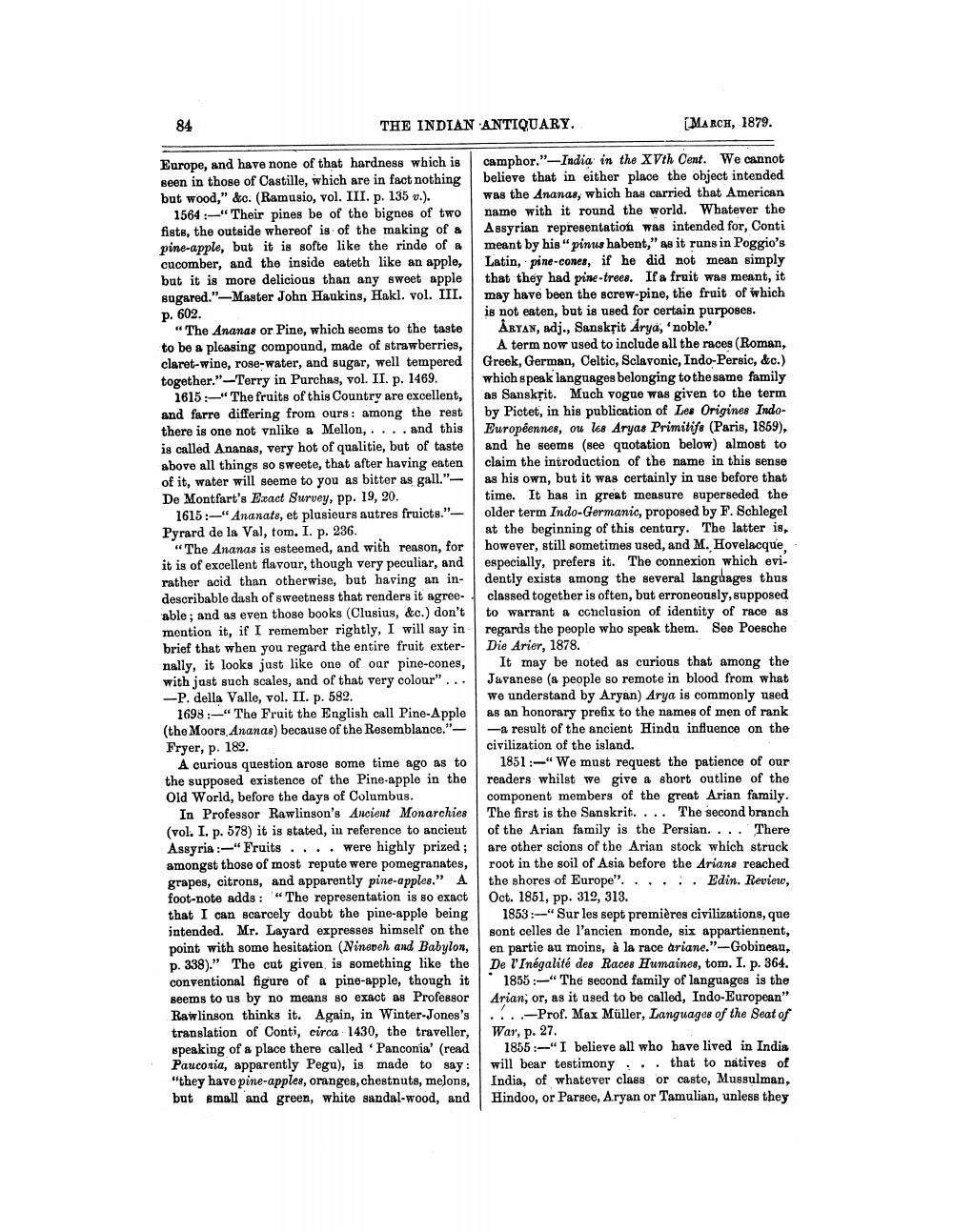________________
84.
THE INDIAN ANTIQUARY.
Europe, and have none of that hardness which is seen in those of Castille, which are in fact nothing but wood," &c. (Ramusio, vol. III. p. 135 v.).
1564"Their pines be of the bignes of two fists, the outside whereof is of the making of a pine-apple, but it is softe like the rinde of a cucomber, and the inside eateth like an apple, but it is more delicious than any sweet apple sugared."-Master John Haukins, Hakl. vol. III. p. 602.
"The Ananas or Pine, which seems to the taste to be a pleasing compound, made of strawberries, claret-wine, rose-water, and sugar, well tempered together."-Terry in Purchas, vol. II. p. 1469.
1615-"The fruits of this Country are excellent, and farre differing from ours: among the rest there is one not vnlike a Mellon,. . . . and this is called Ananas, very hot of qualitie, but of taste above all things so sweete, that after having eaten of it, water will seeme to you as bitter as gall."De Montfart's Exact Survey, pp. 19, 20.
1615:"Ananats, et plusieurs autres fruicts."Pyrard de la Val, tom. I. p. 236.
"The Ananas is esteemed, and with reason, for it is of excellent flavour, though very peculiar, and rather acid than otherwise, but having an indescribable dash of sweetness that renders it agreeable; and as even those books (Clusius, &c.) don't mention it, if I remember rightly, I will say in brief that when you regard the entire fruit externally, it looks just like one of our pine-cones, with just such scales, and of that very colour".. -P. della Valle, vol. II. p. 582.
1698"The Fruit the English call Pine-Apple (the Moors Ananas) because of the Resemblance."Fryer, p. 182.
A curious question arose some time ago as to the supposed existence of the Pine-apple in the Old World, before the days of Columbus.
In Professor Rawlinson's Ancient Monarchies (vol. I. p. 578) it is stated, in reference to ancient Assyria:"Fruits. . . . were highly prized; amongst those of most repute were pomegranates, grapes, citrons, and apparently pine-apples." A
foot-note adds: "The representation is so exact that I can scarcely doubt the pine-apple being intended. Mr. Layard expresses himself on the point with some hesitation (Nineveh and Babylon, p. 338)." The cut given is something like the conventional figure of a pine-apple, though it seems to us by no means so exact as Professor Rawlinson thinks it. Again, in Winter-Jones's translation of Conti, circa 1430, the traveller, speaking of a place there called 'Panconia' (read Pauconia, apparently Pegu), is made to say: "they have pine-apples, oranges, chestnuts, melons, but small and green, white sandal-wood, and
[MARCH, 1879.
camphor."-India in the XVth Cent. We cannot believe that in either place the object intended was the Ananas, which has carried that American name with it round the world. Whatever the Assyrian representation was intended for, Conti meant by his "pinus habent," as it runs in Poggio's Latin, pine-cones, if he did not mean simply that they had pine-trees. If a fruit was meant, it may have been the screw-pine, the fruit of which is not eaten, but is used for certain purposes. ARYAN, adj., Sanskrit Arya, 'noble.'
A term now used to include all the races (Roman, Greek, German, Celtic, Sclavonic, Indo-Persic, &c.) which speak languages belonging to the same family as Sanskrit. Much vogue was given to the term by Pictet, in his publication of Les Origines IndoEuropéennes, ou les Aryas Primitifs (Paris, 1859), and he seems (see quotation below) almost to claim the introduction of the name in this sense as his own, but it was certainly in use before that time. It has in great measure superseded the older term Indo-Germanic, proposed by F. Schlegel at the beginning of this century. The latter is, however, still sometimes used, and M. Hovelacque, especially, prefers it. The connexion which evidently exists among the several languages thus classed together is often, but erroneously, supposed to warrant a conclusion of identity of race as regards the people who speak them. See Poesche Die Arier, 1878.
It may be noted as curious that among the Javanese (a people so remote in blood from what we understand by Aryan) Arya is commonly used as an honorary prefix to the names of men of rank -a result of the ancient Hindu influence on the civilization of the island.
1851" We must request the patience of our readers whilst we give a short outline of the component members of the great Arian family. The first is the Sanskrit. . . . The second branch of the Arian family is the Persian.... There are other scions of the Arian stock which struck root in the soil of Asia before the Arians reached the shores of Europe"...... Edin. Review, Oct. 1851, pp. 312, 313.
1853:-"Sur les sept premières civilizations, que sont celles de l'ancien monde, six appartiennent, en partie au moins, à la race ariane."-Gobineau, De l'Inégalité des Races Humaines, tom. I. p. 364. 1855-"The second family of languages is the Arian, or, as it used to be called, Indo-European"
..-Prof. Max Müller, Languages of the Seat of War, p. 27.
1855-"I believe all who have lived in India will bear testimony that to natives of India, of whatever class or caste, Mussulman, Hindoo, or Parsee, Aryan or Tamulian, unless they




